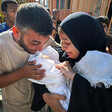Rights and Accountability 31 August 2023

Israelis crowd at the scene of an alleged stabbing attack at a light rail in East Jerusalem in which a Palestinian boy was killed, 30 August,
EFEIsraeli forces shot and killed two Palestinians, one of them 14, in separate incidents in the occupied West Bank on Wednesday and Thursday. Both cases may amount to extrajudicial killings.
On Thursday, Daoud Abd al-Razaq Dares, 41, was killed by guards at Hashmonaim checkpoint northwest of Jerusalem after striking a group of Israeli soldiers with his truck at another checkpoint, killing a soldier and injuring six other people, three of them soldiers.
The soldiers were on their way from an army post to a bus station in order to travel to a “team-building” exercise, Israeli media reported, citing the military.
Israeli authorities said that Dares was attempting a second car ramming attack when he was shot dead.
At least 222 Palestinians were killed by Israeli forces and armed civilians so far this year, or died from previously sustained injuries, according to The Electronic Intifada’s tracking.
Thirty-five people in Israel and Israelis in the occupied West Bank were killed by Palestinians in the context of the occupation during the same period.
There are numerous examples of Palestinians being shot and killed in what Israel says were attempted attacks, only to be later found that no such attack had taken place.
Israeli media reported that Dares, who resided in the West Bank and had a permit to work in Israel, arrived at Maccabim checkpoint, located along the Green Line demarcating Israel and the West Bank, from the western side.
“The driver approached the checkpoint, but suddenly turned the vehicle back towards Israel,” according to the Israeli daily Haaretz, apparently relying on the Israeli military’s account of events. “Only then did the ramming attack take place.”
Haaretz, citing the military, added that “the group of soldiers who were run over are members of an artillery battalion” and had left their post and were walking towards a bus stop, “where the driver noticed them and ran over them.”
A soldier was seriously injured and two others sustained light injuries, according to Haaretz, which said that “two adults in a nearby car, and a Palestinian worker were also injured.”
Israeli authorities claimed that Dares sped away from the scene of the fatal crash and was stopped by guards at a nearby checkpoint, at which point he was shot and seriously wounded. He later died at a hospital.
Israeli authorities said that Dares had attempted a second car ramming attack at the checkpoint where he was killed. However, it is possible that Dares was executed by guards at the second checkpoint, who had been alerted after the crash at the first checkpoint, without having attempted an attack.
Israeli authorities have a long track record of lying about the circumstances in which Palestinians are killed, including when it comes to alleged attacks at checkpoints and those involving the death of Israeli officers and soldiers. Yet Israeli media were quick to describe Dares as a “terrorist,” deferring without skepticism to the Israeli defense ministry narrative.
Dares was a father of five who lived in Deir Ammar near Ramallah, according to Israeli and Palestinian news outlets. Israeli forces raided Dares’ home as the family learned of his death:
Israel’s defense minister Yoav Gallant said that the incident “is an attack with serious consequences.”Checkpoints
Speaking at the checkpoint where the soldier was killed, Bezalel Smotrich, Israel’s extreme-right finance minister, said “we see at this stage the importance of the checkpoints.”
The UN monitoring group OCHA stated last week that there are currently around 650 obstacles impeding Palestinians’ freedom of movement throughout the West Bank – an increase of nearly 10 percent over the number of movement restrictions documented in 2020.
These obstacles include “49 constantly staffed checkpoints; 139 intermittently staffed checkpoints; 304 roadblocks, earth-mounds and road gates; 73 earth walls, road barriers and trenches; and 80 additional obstacles of various types within the Israeli-controlled area of Hebron,” OCHA said.
Israel’s wall in the West Bank and its associated gate and permit regime are the “single largest obstacle to Palestinian movement” in the territory.“These physical obstacles form part of a range of restrictions that the Israeli authorities have imposed on Palestinians since 1967, including permit requirements and the designation of areas as restricted or closed,” according to OCHA.
“Combined, these restrictions impede access to services and resources, disrupt family and social life and undermine Palestinians’ enjoyment of their economic, social and cultural rights, undermine livelihoods and contribute to the fragmentation of the West Bank.”
Checkpoints and other forms of movement restrictions are the sites of frequent violence against Palestinians, with the Switzerland-based Euro-Mediterranean Human Rights Monitor describing them as “death traps … where mere suspicion of Palestinian wrongdoing could lead to immediate killing.”
For years, human rights groups have accused Israel of operating under a shoot-to-kill policy that has transformed police, soldiers and armed civilians “into judges and executioners.”
Palestinian boy executed
That policy appears to have been in play with the apparent extrajudicial killing of a 14-year-old Palestinian who allegedly stabbed and moderately wounded an Israeli in occupied East Jerusalem on Wednesday.
According to Defense for Children International-Palestine, Khaled Samer Fadel al-Zaanin, 14, “allegedly attempted to carry out a stabbing attack in a light rail station before he was knocked to the ground and disarmed by a bystander.”
“An Israeli paramilitary Border Police officer reportedly shot and killed him as he lay on the ground,” the human rights group added.
Video recorded from inside a light rail car appears to show the boy lying on the ground after he was shot in the side. In the video, he is shown alive, but lying on the ground and holding his hands in the air and presenting no conceivable threat, as an Israeli soldier stands over and aims a gun at him.
Another video appears to show the boy lying lifeless on the ground. Additional videos show Israelis cheering as the slain child’s body lays on the ground and is later evacuated from the scene.
At least one person can be clearly heard shouting “death to the Arabs” in Hebrew.
“Israeli authorities confiscated [al-Zaanin’s] body and are withholding it from his family,” according to Defense for Children-International.An eyewitness told an Israeli news outlet that he knocked a knife out of al-Zaanin’s hand before police shot the boy.
This account provides additional evidence that Border Police used lethal force against al-Zaanin when he posed no immediate threat to anyone’s life.
The official Palestinian news agency WAFA, citing local sources, reported that al-Zaanin was left to bleed to death on the street without first aid being rendered.“Israeli forces routinely carry out extrajudicial killings of Palestinians, including children,” said Ayed Abu Eqtaish, a program director at Defense for Children International-Palestine.
“Children suspected of committing criminal acts should be apprehended in accordance with international law and afforded due process of law, not executed on the spot after they no longer pose any threat.”
Border Police officer praised
Kobi Shabtai, Israel’s police commissioner, praised the Border Police officer who killed al-Zaanin, saying that his actions demonstrated “the level of vigilance of our forces in the field, who time and again prevent and thwart terrorist attacks.”
Hours after al-Zaanin was killed, Israeli forces surrounded his family’s home in the Beit Hanina neighborhood of East Jerusalem. His parents, sister and twin brother were detained and interrogated separately at Jerusalem’s infamous Russian Compound before being released, according to Defense for Children International-Palestine.
Videos show the family’s home in disarray after it was ransacked by police:
Israeli occupation forces and settlers have killed at least 42 Palestinian children since the beginning of the year, according to The Electronic Intifada’s tracking. This figure includes a boy in Gaza who died as a result of injuries sustained in an Israeli airstrike last year.Earlier this week, Human Rights Watch called for an end to the “systematic impunity for unlawful lethal force” used by Israeli military and border police forces against Palestinian children.
The New York-based rights group observed that Palestinian children are killed “with virtually no recourse for accountability.”Last year was the deadliest for Palestinian children in the West Bank in 15 years and “2023 is on track to meet or exceed 2022 levels,” Human Rights Watch added.
“Unless Israel’s allies, particularly the United States, pressure Israel to change course, more Palestinian children will be killed,” said Bill Van Esveld, an associate director at Human Rights Watch.





